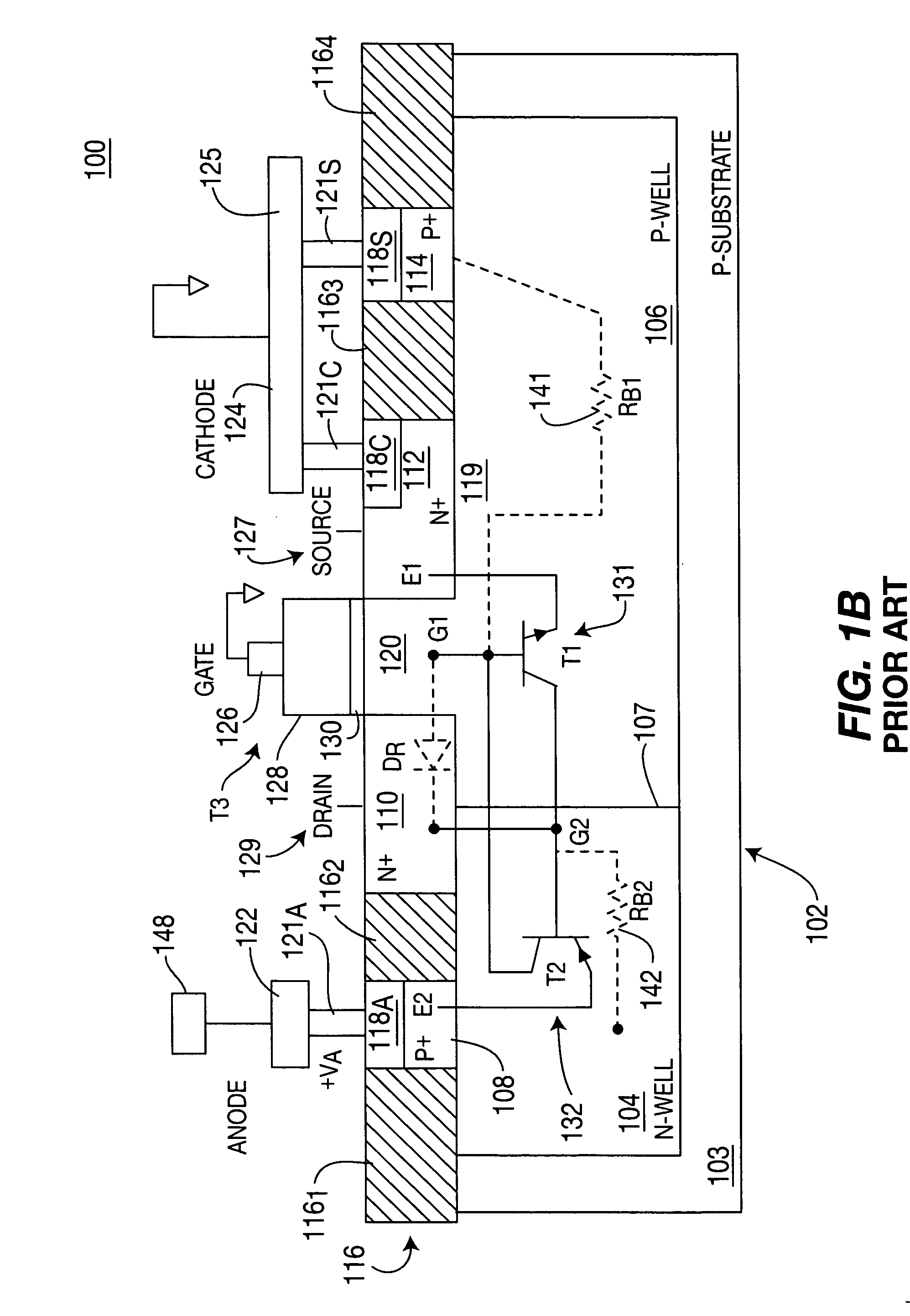Silicon controlled rectifier electrostatic discharge protection device for power supply lines with powerdown mode of operation
a technology of electrostatic discharge protection and silicon control, which is applied in the direction of semiconductor/solid-state device details, diodes, transistors, etc., can solve the problems of slow scr triggering, esd problem is particularly pronounced, and the product needs expensive repairs
- Summary
- Abstract
- Description
- Claims
- Application Information
AI Technical Summary
Benefits of technology
Problems solved by technology
Method used
Image
Examples
second embodiment
[0083]FIG. 6 depicts a cross-sectional view of a SCR 602 of the NMOS-triggered SCR ESD protection device 201. Specifically, FIG. 6 represents an SCR 202 that is fully silicided over the P+ and N+ regions 308 and 312. The base widths WN and WP of the transistors T2232 and T1231 are shown, respectively. Furthermore, shallow trench isolation (STI) is disposed over the entire SCR 202 as shown by STI regions 3161, 616, 3163, and 3164. In particular, the STI region 616 is disposed on the surface area 309 between the silicided layers 618A and 618C. Accordingly, the STI region 616 serves as an isolator between the anode 122 and cathode 124 to prevent shorting between the respective silicide layers 618A and 618C.
[0084] Moreover, the respective base widths WN and WP of the transistors T2232 and T1231 are determined by the length of the STI region 616. In particular, during manufacturing of the IC 200, the STI material is selectively deposited over the SCR 202. Thereafter, the P+ and N+ doped ...
first embodiment
[0095]FIG. 10 depicts a schematic diagram of an SCR ESD protection device 1000 of the present invention having two NMOS trigger devices 10201 and 10202 (collectively NMOS trigger devices 1020). In particular, the ESD protection device 1000 comprises a first SCR 10021 having a trigger NMOS device 10201, and a second SCR 10022 having an NMOS trigger device 10202, where both SCR's 10021 and 10022 (collectively SCRs 1002) are coupled between a first power line 10501 and a second power line 10502. The first SCR device 10021 is represented by a PNP transistor 10041 and an NPN transistor 10061. Similarly, the second SCR device 10022 is represented by a PNP transistor 10042 and an NPN transistor 10062, and both SCRs 1002 are configured in a conventional manner as discussed above with the respect to FIGS. 2A and 2B.
[0096] In particular, the emitter of the NPN transistor 10061 forms the cathode of the SCR 10021, the collector of the NPN transistor 10061 is coupled to the base of the PNP trans...
third embodiment
[0121]FIG. 12 depicts a schematic diagram of an SCR ESD protection device 1200 of the present invention having a diode trigger device 1202. FIG.12 is the same as FIG. 10 except that each NMOS trigger device 1020 is replaced by one or more serially coupled trigger diodes 1202.
[0122] For example, three exemplary diodes are serially coupled in a forward conduction direction from the emitter (anode) of the PNP transistor 10041 to the first gate G110081 of the first SCR 10021. Similarly, three exemplary diodes are illustratively serially coupled in a forward conduction direction from the emitter (anode) of the PNP transistor 10042 to the first gate G110082 of the second SCR 10022. Thus, both SCR's 1002 are triggered by the serially coupled diodes 1202.
[0123] Further, with respect to the third embodiment of FIG. 12, the N-wells of the two anti-parallel SCRs 1002 may be left floating or may be connected to a corresponding anode for each SCR to control the trigger and holding currents, or ...
PUM
 Login to View More
Login to View More Abstract
Description
Claims
Application Information
 Login to View More
Login to View More - R&D
- Intellectual Property
- Life Sciences
- Materials
- Tech Scout
- Unparalleled Data Quality
- Higher Quality Content
- 60% Fewer Hallucinations
Browse by: Latest US Patents, China's latest patents, Technical Efficacy Thesaurus, Application Domain, Technology Topic, Popular Technical Reports.
© 2025 PatSnap. All rights reserved.Legal|Privacy policy|Modern Slavery Act Transparency Statement|Sitemap|About US| Contact US: help@patsnap.com



